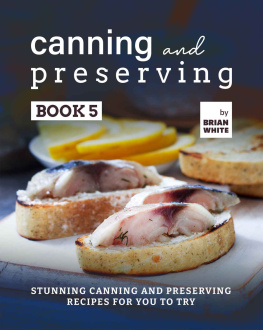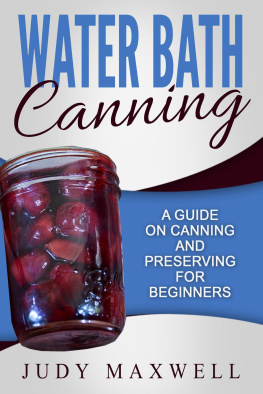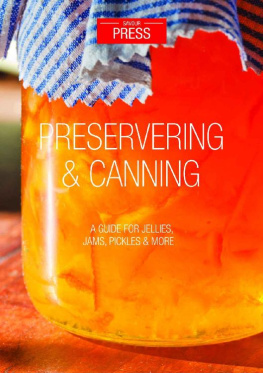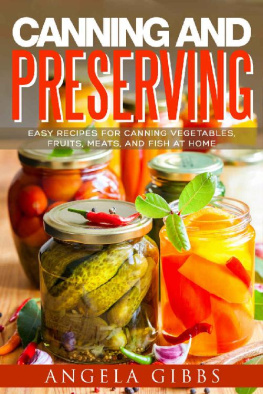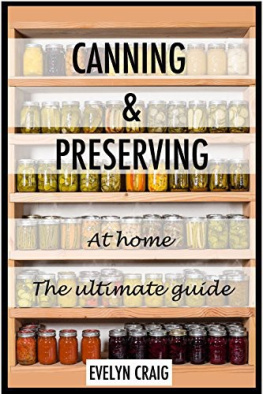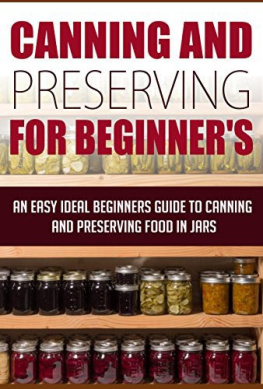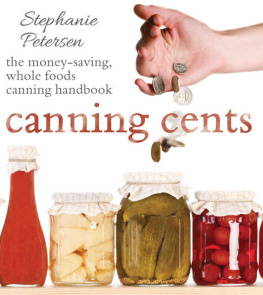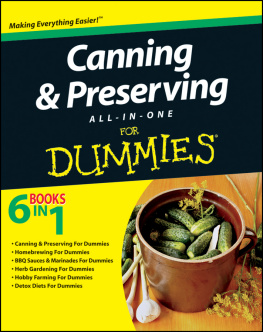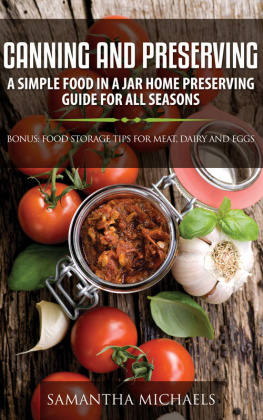This book is dedicated to thosewho love to live the simpler life and always be prepared for times of scarcity.
Chapter 1- What is Home Canning & Preserving?
Homefood preserving is making a comeback in light of concerns about health risksfrom commercial preservation methods. Home food preservation enthusiasts alsopoint to the savings that are possible by buying and preserving things likemeat at bulk prices and preserving it. Buying seasonal fruits and vegetables attheir lowest prices of the year or producing them from your own garden andpreserving them is also an excellent way of having great tasting food all yearlong and saving a lot of money.

Thereare many methods of preserving food and commercial methods have increasinglyrelied on the addition of artificial preservatives to eliminate and controlmold or fungus and reduce oxidation of food ingredients. These additives havethe advantage of greatly extending shelf life and allowing food to be shippedfurther and stored longer before it is ultimately consumed.
Homefood preservation avoids many of the additives used in commercial food industryand relies on some old techniques with the help of some new technology. Hereare some of the most popular home food preservation techniques that are makinga comeback.
Canningcan be used to prolong the shelf life of a wide variety of fruits, vegetablesand even meat. Canning fresh fruits and vegetables is the most common type ofhome canning. The fresh fruits or vegetables are carefully selected, cleaned toremove stems, dirt, leaves etc. and then sometimes peeled. Before being placedin jars the jars are placed in boiling water to sterilize them. The fruits orvegetables are then heated and depending on the type of fruit or vegetable,acid, such as vinegar or lemon juice is added and they are sealed in the jars.Fruits that are slightly acidic lend themselves well to canning withoutadditional acid. Many recipes for canning include either syrup, a mixtureincluding sugar, or brine, a salty mixture.
Makingjam was a traditional activity in most early North American homesteads.Homesteading families would cultivate their own strawberries and raspberriesand go in search of wild blueberries, loganberries, chokecherries and the like.All of the fruit from the summer would be either canned or made into jam.Making jam is very similar to canning fruit with the addition of a thickeningagent. Sometimes the thickening agent can simply be more sugar or you can usepectin. Basic fruit jams can also be flavored with spices like basil, cinnamonor mint to imbue them with an exotic flavor.
Picklingis another food preservation technique related to canning. Pickling isparticularly popular for vegetables and has deep ethnic roots with many of theearly European settlers of North America. The always reliable cucumber and alsopeas, corn, carrots and even fruit like mangoes have found new fans as pickles.Meats, like pickled pigs feet, cows tongue, and many types of fish haveestablished themselves as delicacies. The second main variety of vegetablepickle you find in stores is the sweet pickle. These pickles typically addgarlic and sugar to the recipe.
Dehydratingor drying food as a method of preservation has been around for at least 10,000years and possibly longer. Home drying is most commonly used for things likespices and herbs but it can be used for almost any food including meat,vegetables and fruit. Dehydrated foods have become particularly popular withback-country sports enthusiasts. Mountain climbers, hikers, mountain bikers,and canoeists appreciate the reduction in weight that dehydrated food providesan avid outdoorsmen have taken up dehydrating their own food to avoid the costof commercially dehydrated food and to expand their menu choices.
Youcan dehydrate food at home as simply as hanging some fresh cut herbs near asunny window or using a microwave if only a small amount of herb needs to bedried. Drying herbs has the advantage of creating a year round supply fromherbs that you grow in your own backyard during the summer. Dried herbs take uprelatively less room and are 3 to 4 times stronger than fresh. You only need1/3 as much or less dried herb if you are substituting for fresh.
Dryingmeat, vegetables and fruit is most easily done with a food dehydrator. Smallhome appliance food dehydrators can be purchased for as little as $50 or $60but if you are planning to dehydrate a substantial amount for winterconsumption or regularly want to dry all your food for extended back-countryactivities then you should consider a basic model of a commercial gradedehydrator. A commercial dehydrator can accommodate more food in each dryingcycle so it saves a lot of time and money by bulk drying.
Smokingis perhaps one of the earliest methods of preserving meat and fish. It likelydeveloped along with cooking meat using fire. The purchase and use of home meatsmokers has mushroomed. Models are available that run on gas, electricity orwood. The basic recipe for curing and smoking meat requires three ingredients;salt, smoke and heat. Smoke acts as both an antioxidant and an antimicrobialagent to preserve the meat.
Makingwine is also an ancient method of preserving food. Growing grapes to make winegoes back to ancient Mesopotamia and was an important element in the culture ofancient Egypt, Greece and Rome. Home wine-making is increasing in popularitypartly because it is an enjoyable hobby that lets participants share thehistory and tradition of the ancient art of wine-making. There are manycommercial wine-making kits available for the beginner that includes grapejuice concentrate but the purist will want to crush their own grapes.
Smallbatch grape crushers start at around $300. If you just want to give it a tryyou can start off with some plastic buckets, the kind that you get at a homeimprovement store, and a length of 4X4 beam as your crusher. Although woodenbarrels made of oak used to be standard for aging wine it is now much morecommon and economical to use stainless steel. Home winemakers can use plasticcontainers and use oak chips to infuse the familiar oak flavor of barrel aging.
Chapter 2- What Are the DifferentTypes of Home Canning?
Understandingcanning involves learning the two basic types. We will discuss them both here,and they are 'boiling water bath' canning and 'pressure' canning. Understandingthese two different types of canning will improve the success of your canningendeavors.


